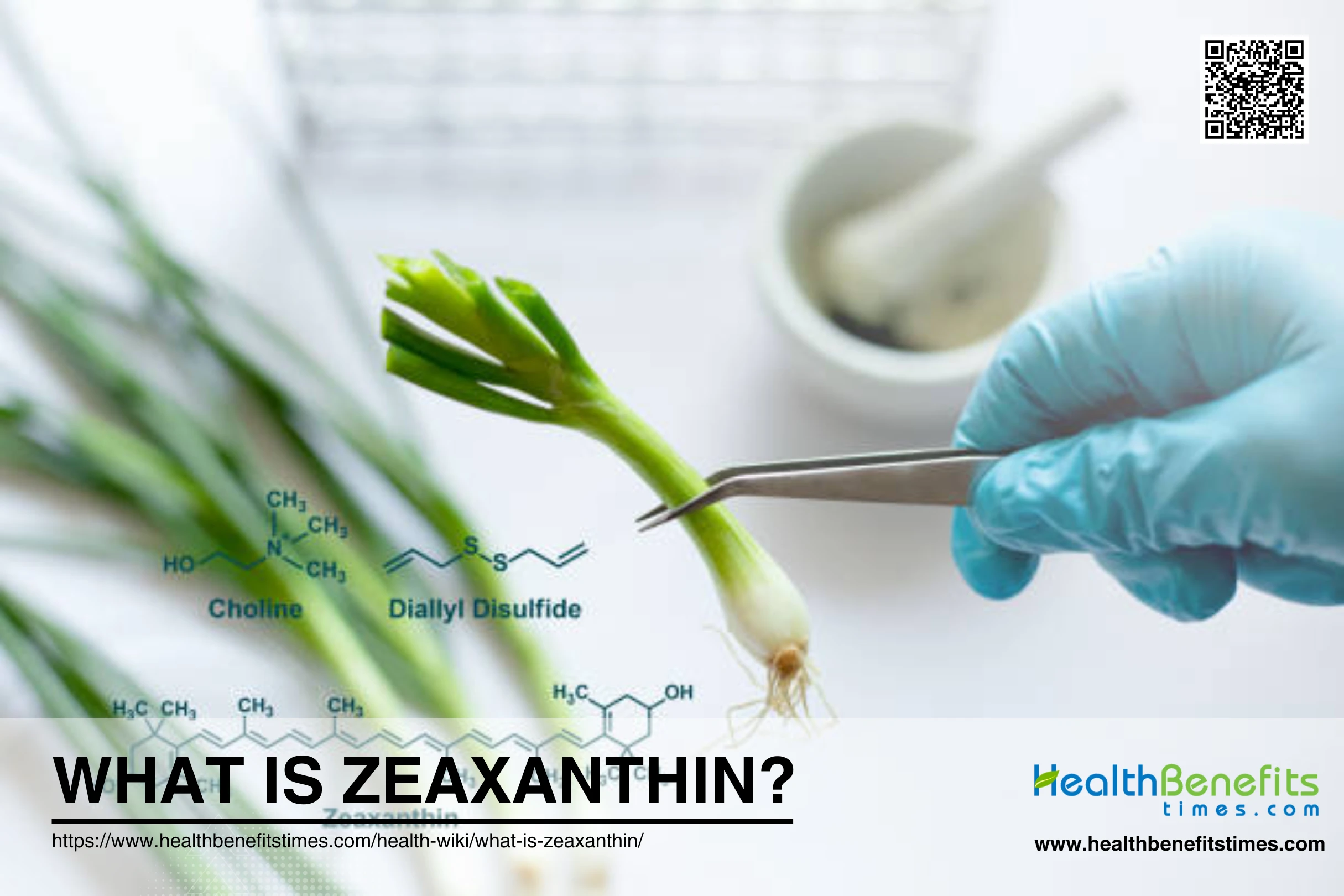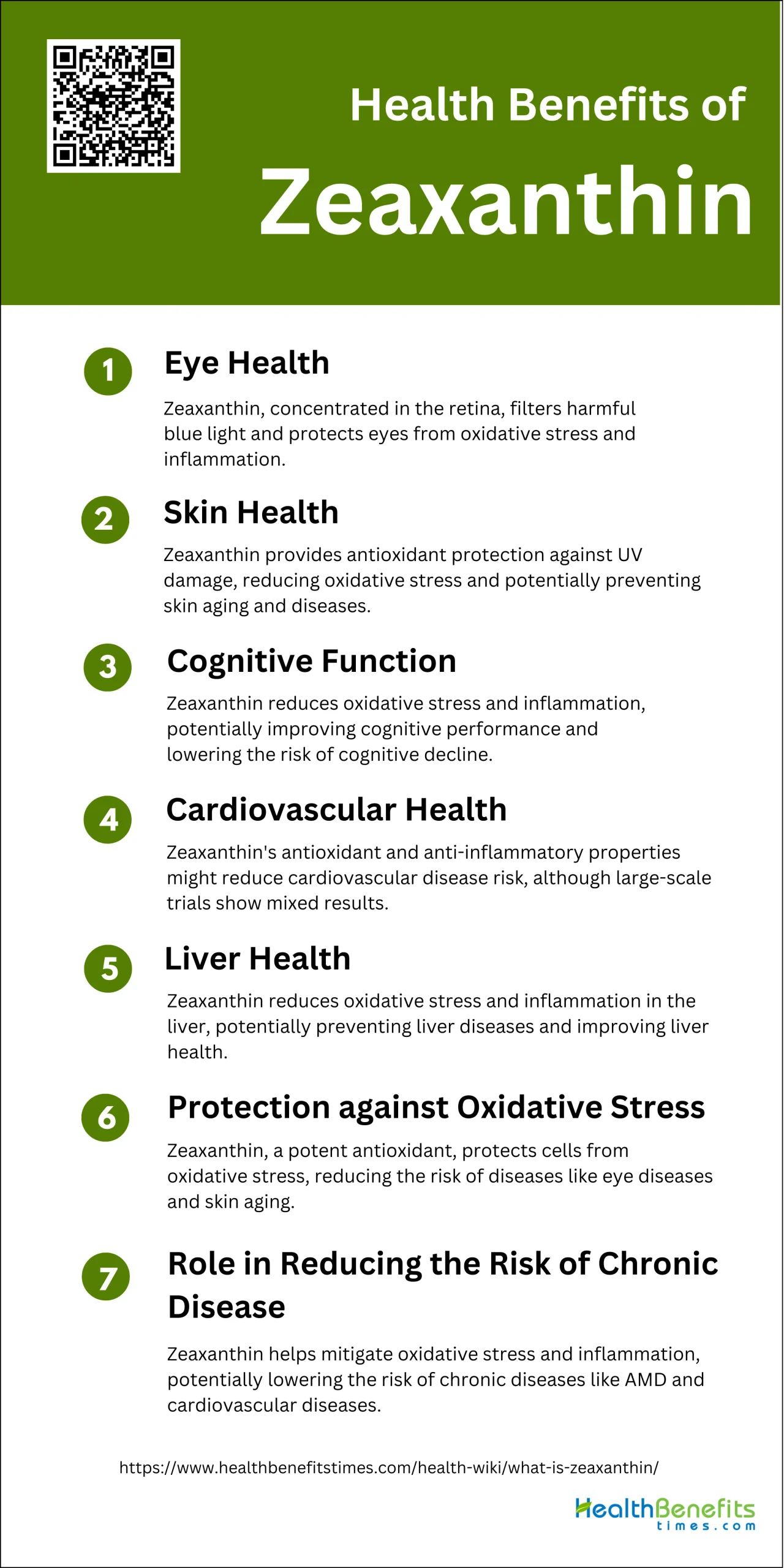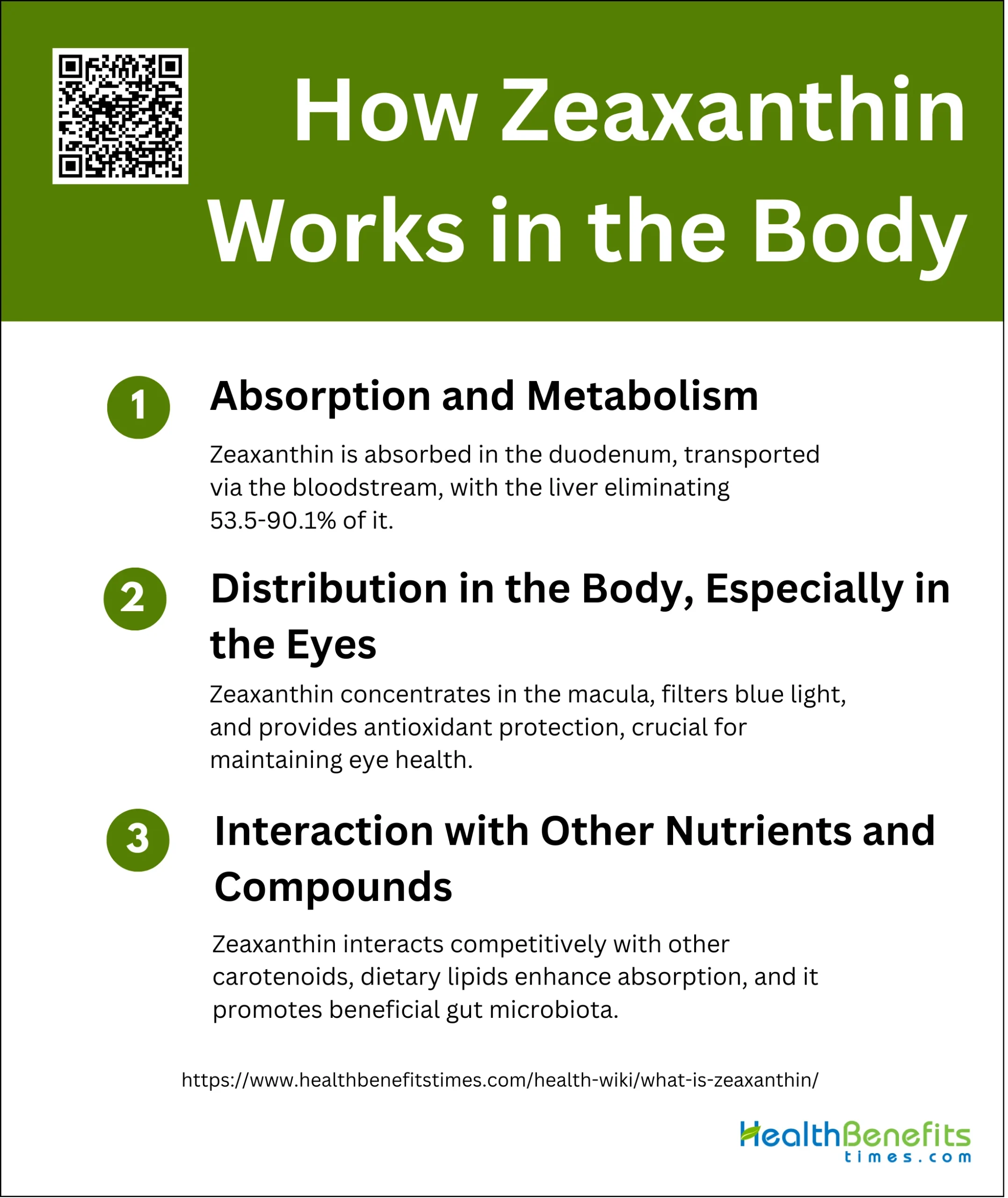 Zeaxanthin is a carotenoid pigment belonging to the xanthophyll subclass, prominently found in the retina, particularly in the macula. It plays a crucial role in eye health by acting as a natural filter against harmful blue light and serving as an antioxidant to protect ocular cells from oxidative stress. Zeaxanthin, along with lutein, is integral in reducing the risk of age-related macular degeneration and other eye diseases. These pigments are sourced from various green leafy vegetables and other foods, contributing to their nutritional and protective benefits against cellular damage and age-related issues.
Zeaxanthin is a carotenoid pigment belonging to the xanthophyll subclass, prominently found in the retina, particularly in the macula. It plays a crucial role in eye health by acting as a natural filter against harmful blue light and serving as an antioxidant to protect ocular cells from oxidative stress. Zeaxanthin, along with lutein, is integral in reducing the risk of age-related macular degeneration and other eye diseases. These pigments are sourced from various green leafy vegetables and other foods, contributing to their nutritional and protective benefits against cellular damage and age-related issues.
Chemical structure and properties
Chemical structure plays a crucial role in determining the properties of compounds, and various methods have been developed to elucidate these relationships. Graph theoretical approaches model compounds as graphs to analyze structure-property-activity problems, such as diamagnetic susceptibility and boiling points in alkanes. Machine learning models, like recursive neural networks, have shown promise in predicting physical-chemical properties by directly using molecular structures as input. Quantum chemical topology analysis further aids in understanding chemical reactivity and bonding by examining electron density and localization functions. Additionally, quantitative structure-property relationships (QSPRs) leverage molecular descriptors to predict properties, facilitating the design of new molecules with desirable characteristics. These diverse methodologies underscore the importance of chemical structure in predicting and understanding the properties of compounds.
Natural sources of zeaxanthin
Zeaxanthin is naturally found in a variety of fruits, vegetables, and other foods. Some of the richest sources include:
- Egg yolks: A significant source of zeaxanthin, contributing to its high bioavailability.
- Corn (maize): Contains high levels of both lutein and zeaxanthin, making it a staple for these carotenoids.
- Orange peppers: Noted for their high zeaxanthin content, providing a substantial amount relative to other vegetables.
- Green leafy vegetables: Such as spinach and kale, which also contain notable amounts of lutein alongside zeaxanthin.
- Other vegetables: Including zucchini, pumpkin, and green garlic shoots, which offer varying levels of zeaxanthin.
- Fruits: Like kiwi and grapes, which provide a moderate amount of zeaxanthin.
Health Benefits of Zeaxanthin
Zeaxanthin is a powerful antioxidant found in various fruits and vegetables. It plays a significant role in maintaining overall health by protecting cells from oxidative damage. Below are some of the key health benefits of zeaxanthin:
1. Eye Health
Zeaxanthin, along with lutein, is concentrated in the retina and lens of the eye, where it plays a crucial role in maintaining eye health. These carotenoids are known for their ability to filter harmful blue light and act as antioxidants, protecting the eyes from oxidative stress and inflammation. Studies have shown that zeaxanthin can help delay the progression of age-related macular degeneration (AMD) and cataracts, two common eye diseases associated with aging. The protective mechanisms include quenching free radicals and reducing the production of inflammatory markers.
2. Skin Health
Zeaxanthin also contributes to skin health by providing antioxidant protection against UV-induced damage. Its ability to quench free radicals helps in reducing oxidative stress, which is a major factor in skin aging and the development of skin diseases. Although the specific effects of zeaxanthin on skin health are less studied compared to its effects on eye health, its general antioxidant properties suggest potential benefits in maintaining skin integrity and preventing damage from environmental stressors.
3. Cognitive Function
Emerging research suggests that zeaxanthin may have a positive impact on cognitive function. The antioxidant properties of zeaxanthin help in reducing oxidative stress and inflammation, which are linked to cognitive decline and neurodegenerative diseases. While more research is needed to fully understand the mechanisms, initial studies indicate that higher levels of zeaxanthin in the diet could be associated with better cognitive performance and a lower risk of cognitive impairment.
4. Cardiovascular Health
Zeaxanthin has been studied for its potential benefits in cardiovascular health. Its antioxidant and anti-inflammatory properties may help in reducing the risk of cardiovascular diseases. However, large-scale clinical trials, such as the Age-Related Eye Disease Study 2 (AREDS2), have not found significant evidence that zeaxanthin supplementation alone reduces the risk of cardiovascular events. Despite this, the general antioxidant effects of zeaxanthin suggest it could still play a supportive role in cardiovascular health.
5. Liver Health
Zeaxanthin’s antioxidant properties extend to liver health as well. It helps in reducing oxidative stress and inflammation in the liver, which are key factors in the development of liver diseases. Animal studies have shown that zeaxanthin can ameliorate conditions like colitis by modulating pro-inflammatory cytokines and oxidative stress markers, suggesting potential benefits for liver health as well.
6. Protection against Oxidative Stress
Zeaxanthin is a potent antioxidant that helps protect cells from oxidative stress by quenching free radicals. This protective effect is crucial in preventing cellular damage and reducing the risk of various diseases, including eye diseases, skin aging, and potentially neurodegenerative and cardiovascular diseases. Its ability to reduce oxidative stress makes it a valuable nutrient for overall health maintenance.
7. Role in Reducing the Risk of Chronic Diseases
Zeaxanthin’s antioxidant and anti-inflammatory properties contribute to its role in reducing the risk of chronic diseases. By mitigating oxidative stress and inflammation, zeaxanthin helps in lowering the risk of chronic conditions such as age-related macular degeneration, cardiovascular diseases, and potentially neurodegenerative diseases. While more research is needed to fully establish these benefits, current evidence supports the inclusion of zeaxanthin-rich foods in the diet for long-term health benefits.
How Zeaxanthin Works in the Body
Zeaxanthin is a carotenoid that functions as a potent antioxidant, protecting cells from oxidative damage. It is absorbed in the body and accumulates in various tissues, providing numerous health benefits. Below are some of the key ways zeaxanthin works in the body:
1. Absorption and Metabolism
Zeaxanthin, a dietary carotenoid, is primarily absorbed in the duodenum, although a significant portion remains unabsorbed throughout the gut tract. Its poor solubility and stability in gut luminal fluids contribute to this limited absorption. Once absorbed, zeaxanthin is transported via the bloodstream, with the liver playing a major role in its elimination, accounting for 53.5-90.1% of the total clearance process. Additionally, zeaxanthin’s bioavailability can be influenced by dietary factors and the presence of other carotenoids, such as lutein and beta-carotene, which can competitively inhibit its absorption and transport.
2. Distribution in the Body, Especially in the Eyes
Zeaxanthin is uniquely concentrated in the human macula, where it plays a crucial role in filtering blue light and providing antioxidant protection. This concentration is facilitated by high-affinity binding proteins and specialized transport mechanisms. In the retina, zeaxanthin, along with lutein, accumulates significantly, with dietary supplementation shown to increase retinal concentrations by over 100% in animal models. This accumulation is essential for maintaining eye health and protecting against age-related macular degeneration and other ocular diseases.
3. Interaction with Other Nutrients and Compounds
Zeaxanthin interacts with other carotenoids, such as lutein and beta-carotene, in a competitive manner, affecting their absorption and tissue distribution. High doses of one carotenoid can decrease the plasma and tissue concentrations of the others. Additionally, zeaxanthin’s interaction with dietary lipids can enhance its lymphatic absorption, as certain lipids have been shown to improve its bioavailability. Furthermore, zeaxanthin can influence gut microbiota composition, promoting beneficial bacterial populations and altering metabolomic profiles, which may have broader implications for host metabolism and health.
Zeaxanthin in the Diet
Daily Recommended Intake
The recommended daily intake of zeaxanthin is approximately 2 mg per day. This recommendation is based on studies that have shown the beneficial effects of zeaxanthin in delaying the progression of eye diseases such as age-related macular degeneration (AMD) and cataracts. Zeaxanthin, along with lutein, is one of the only dietary carotenoids that accumulate in the retina, specifically the macula, where they play a crucial role in protecting against oxidative stress and scavenging free radicals. Ensuring an adequate intake of zeaxanthin is essential for maintaining eye health and preventing degenerative eye conditions.
Tips for Increasing Zeaxanthin Intake
To increase zeaxanthin intake, focus on incorporating foods rich in this carotenoid into your diet. Key sources include dark green leafy vegetables such as kale, spinach, and broccoli, as well as other vegetables like peas and corn. Additionally, egg yolks and pistachio nuts are highly bioavailable sources of zeaxanthin. Cooking methods can also impact the bioavailability of zeaxanthin; for instance, lightly steaming vegetables can help preserve their nutrient content. Including healthy fats in your meals, such as olive oil or avocado, can enhance the absorption of zeaxanthin, as carotenoids are fat-soluble.
Example Meal Plans Rich in Zeaxanthin
A meal plan rich in zeaxanthin could include a variety of foods to ensure adequate intake. For breakfast, consider an omelet made with spinach and topped with avocado. For lunch, a salad with kale, broccoli, peas, and a dressing made with olive oil can be both nutritious and delicious. Dinner could feature a side of steamed corn and a main dish of grilled chicken or fish. Snacks throughout the day might include pistachio nuts or a smoothie made with dark leafy greens and fruits. These meal options not only provide zeaxanthin but also offer a range of other essential nutrients.
Potential Side Effects and Safety
1. Known Side Effects
Creatine supplementation is generally considered safe for short-term use, but several side effects have been reported. The most common side effect is weight gain due to water retention, which can affect performance in activities dependent on body mass, such as running and swimming. Gastrointestinal complaints are also frequently noted, particularly with long-term use. There are concerns about potential renal impairment, although studies have shown mixed results. Some case reports have linked creatine to acute interstitial nephritis, while systematic reviews suggest no significant impact on renal function. Additionally, mild airway inflammation has been observed in athletes, and chronic use may lead to the production of toxic aldehydes, potentially causing vascular damage and other complications.
2. Safety Considerations
The safety of creatine supplementation varies depending on the duration and dosage. Short-term use at recommended doses is generally well-tolerated and does not significantly affect renal or hepatic function. Long-term use, particularly in older adults or those with pre-existing conditions, requires careful monitoring. Studies in aged patients with Parkinson’s disease have shown that creatine is well-tolerated over two years, with no significant renal impairment. However, chronic administration may lead to the production of formaldehyde, a known environmental risk factor, which could pose long-term health risks. Therefore, it is crucial to conduct large, randomized controlled trials to evaluate the long-term safety of creatine across various organ systems.
3. Interactions with Medications
Creatine supplementation can interact with other medications, potentially exacerbating side effects or reducing efficacy. For instance, combining creatine with caffeine has been studied, and no significant adverse effects were found in short-term use. However, the interaction between creatine and other common medications, such as those affecting renal function, remains under-researched. In a case study, a young weightlifter experienced acute renal failure while taking multiple supplements, including creatine, suggesting that creatine may interact with other substances to cause adverse effects. Therefore, individuals on medication should consult healthcare providers before starting creatine supplementation to avoid potential interactions and ensure safe use.



